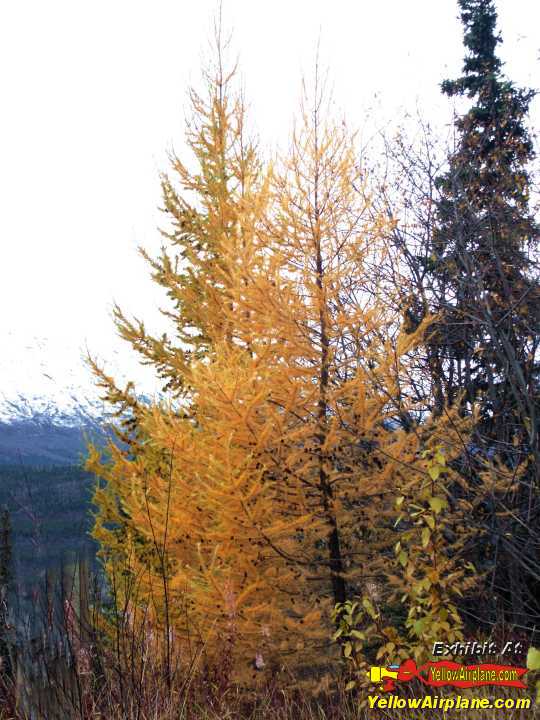|
I'm not truly sure if this a Tamarack tree or
a Larch, but after looking at the picture I do believe it is a Tamarack.
Not like other Conifers which hold their needles all year round, the Tamarack
and Larch trees are deciduous and lose their needles in the winter. The Latin name for Tamarack is Larix
laricina. The Chippewa word for the tamarack is "Muckigwatig" which means
"Swamp Tree." The Tamarack tree usually grows in swamps and bogs but these
trees were growing on a hillside that was relatively dry.
These are Tamarack Trees near the Matanusra
Glacier State Recreation Site on Alaska Highway 1 about two thirds the way from
Glenallen to Palmer Alaska. This is an absolutely fantastic drive, one of
the most beautiful that I have ever seen. To the left and looking back
toward the South you can see the Matanusra Glacier. After looking at
the pictures on Google Earth, The Matanusra Glacier is one place that I wanted
to stop to see.
The Tamarak Tree was one that I have never
heard of before. The tree looks like any other evergreen tree, but it
turned yellow and lost it's needles in the fall. I have seen these before
in the city of Khatanga in Northern Siberia, but they didn't have any leaves at
all and I never put the connection together until I saw these trees.
Click Here to see the Tamarack Trees in Northern Siberia.
The Natives use the tamarack tree wood for
snowshoes. It commonly grows in
swamps and sphagnum bogs but also grows in upland soils.
In the spring, the tender shoots are nutritious and can be eaten after they are
boiled. The inner bark, called the cambium layer, can be scraped and dried
then ground into a meal used to be mixed with other flours. Also the gummy
sap seeping from the tree has a very good flavor that is sweet as maple sugar
and can be chewed. The Tamarack
tree can also be used as a medicine. A tea which is made from the tamarack
bark can be used as a laxative, tonic, rheumatism, a diuretic for jaundice and
skin ailments. It can also be gargled for sore throats. For sores,
swellings and burns the inner bark and leaves can be applied as a poultice.
Also the gum from a Tamarack tree can be chewed for indigestion.
Because of its astringent
and gently stimulating qualities the inner bark is especially useful for
melancholy, often caused by the enlarged, sluggish, hardened, condition of the
liver and spleen with inactivates various other functions of the metabolism.
It can also be used for
use in emergencies, or long-standing bleeding of any kind, in lungs, stomach,
bowels, or profuse menstruation.
Also for diarrhea,
rheumatism, bronchitis, asthma and poisonous insect bites. Also recommended is
the weak tea as an eye wash and the warm tea dropped in the ear to relieve
earache. A decoction of the bark, combined with Spearmint (Mentha veridis),
Juniper (Juniperus communis), Horse radish (Cochlearia armoracia), and taken in
a wine glass dose has proven valuable in dropsy.
The recommended tea is made from one
teaspoon of the inner bark boiled and steeped for thirty minutes in a cup of
water. For burns, the
inner bark is finely chopped and applied directly to the burn in the morning and
lightly washed off at night, then reapplied on the next morning.
The outer bark of the tamarack tree can be
used for tanning hides of animals.
The tamarack or
hackmatack has been an excellent timber much used for ships. It is practically
indestructible under water and stands very well even where exposed. It is used
to be the colonial substitute for the ‘compass timber’ of English oak used in
the ships of the Royal Navy, it’s roots furnishing the natural knees and other
curved pieces so precious to the early shipbuilders. Unfortunately the tamarack
as a commercial timber is no more, for some years ago an insect pest swept the
country and destroyed all the trees of any size. Their gaunt skeletons, bare,
grey and dry as tinder, may still be seen standing in northern bogs and muskegs,
a tribute to the species durability. Fortunately new growth is rapidly coming
on. (Lower, A. 1938)
The roots to the Tamarack tree can be
used to make woven bags. The roots are stripped of their bark and then
boiled making them pliable. Larger tamarack rots are stripped of their
bark and are used to sew the edges of canoes. |


